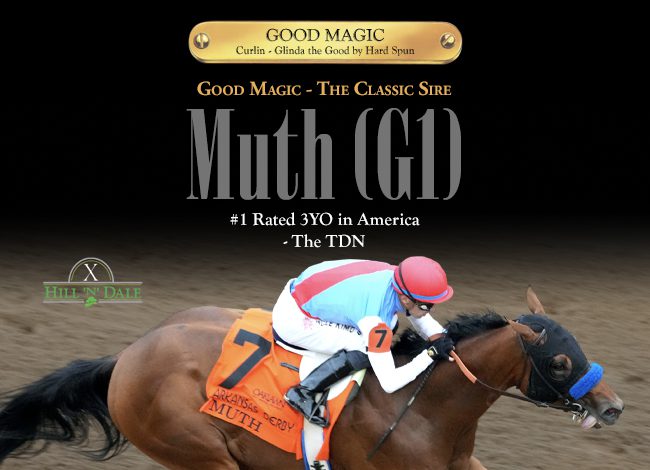By Robert D. Fierro
One might conclude from all the medal tossing and justifiable kudos that Norway invaded South Korea last month and came home with a holy grail. Not so fast, folks.
Despite the experts opining that the United States underachieved in the Winter Olympics, and notwithstanding the dancing and sweeping and brushing on the ice and swooshing and boarding on the snow that those brave forces achieved, there was virtually no coverage of a substantial triumph racked up by other highly talented athletes in that country just before the Olympic Games began. The fact that those athletes happen to have four legs and their achievements were based on their records as progenitors matters mightily to our discussion, and here they are:
1) Eighteen of the Top 20 Korean-based sires in 2017 were bred in the United States, another was bred in Brazil and sired by a GI Kentucky Derby winner and stood in Florida before being exported, and the 20th was bred in Japan.
2) Leading Sire for the sixth straight year was Menifee, a son of Harlan (by Storm Cat).
This is an exceptional record but not unusual in a country which has literally built its racing industry on American sire-lines. But it is the evolution of the quality of the stallions, and what it took to get there, that is the real story here. Some background is necessary, however.
Your correspondent is not an expert on Korean racing but was involved in a brief search in the late 1990s for high quality stallion prospects which raced in North America, working with a very prominent international bloodstock agent and a team of Korean veterinarians.
After being shown more than half a dozen Group 1 winners at Belmont Park, and hearing their race records, the vets were exasperated. Why? All of them were middle to long distance Group 1 winners on the turf. Problem is there is no turf in Korea, and the vast majority of races used to be at six furlongs.
(Noting that they were just this side of being depressed, and knowing one of them understood some English, your correspondent asked if they were hungry. I told them that we were only a few miles from Flushing, Queens–at that time the home of the largest concentration of Korean-Americans in the United States. They beamed and almost danced out of the car on Main Street and one supposes vanquished their depression, and hunger, in a ton of poached octopus, bar-b-que and kimchi).
That vignette is more easily understood by looking at the Leading Sire list in Korea last year (below). Note that there are no readily recognizable turf horses on the list, but there has been a major shift in selection which will become apparent as we go on.
NOTES: There is a wide distribution of sire lines on this list, and for the most part the relative high quality of racing careers, and sometimes very decent sire records in North America. Most of these horses are familiar to North American breeders except, perhaps, for Colors Flying (winner of one race out of champion Storm Flag Flying). The Japanese stallion's sire, White Muzzle, is a son of Dancing Brave (Lyphard). Note also that Hansen makes the list despite having only 2-year-olds (Menifee was ahead of him as Leading Juvenile Sire).
What is most interesting about this list, however, is how it compares to those since 2000. Here is a link to the Leading Sires lists in Korea.
If you work your way to or from 2000 you will see that the Koreans decided to diversify the aptitudes of their sires as they diversified their racing program. Though many of the leading sires from the early 2000s were bred in North America, one would think that many are not quite familiar.
What is most telling, however, is the way the country's Triple Crown has demonstrated the sharp contrast in the way the stallion population has developed. It is not quite clear if the Triple Crown was officially adopted in 2010 or 2011. But what is quite clear is that except for four Japanese breds (Biwa Shinseiki, Ingrandire Hat Trick and Meisei Opera), all the winners were sired by American breds who were noted in this country for getting horses that could excel at all distances. The list that follows show these races in the order in which they are run, from left to right. (In 2016, Menifee's son Power Blade won the Triple Crown).
Except for Menifee there is a wide diversity of bloodlines in this group, a sign of a shift in cultural as well as aptitude values on the part of the South Korean Thoroughbred industry. It is that same diversity that has built the American Thoroughbred population over the past century, much in the same way as its human population has developed.
And while we may have lost the overall rush for the gold to Norway in Pyeongchang, there were more than a few USA medal winners and competitors from the upper Midwest with some (or lots of) Norwegian in their genes–some of which were blended with the DNA of other lands, other cultures, other races, to build a winning team.
Bob Fierro is a partner with Jay Kilgore and Frank Mitchell in DataTrack International, biomechanical consultants and developers of BreezeFigs. He can be reached at [email protected]).
Not a subscriber? Click here to sign up for the daily PDF or alerts.






